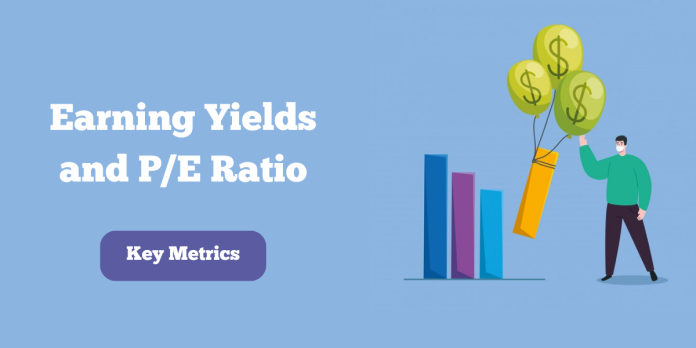Introduction
Investing in the stock market can be a daunting task for both beginners and experienced investors alike. While there are countless financial metrics and ratios to consider, two of the most crucial ones are earning yields and Price-to-Earnings (P/E) ratio. These metrics are fundamental in assessing the value and growth potential of a company’s stock. Understanding the differences between these metrics is vital for investors seeking to make informed decisions and maximize their investment returns.
In this comprehensive blog post, we will delve into the differences between earning yields and P/E ratios, their advantages and disadvantages, and provide real-world examples to illustrate their significance in the world of investing.
Earning Yields
Earning yields, often referred to as earnings yield, is a measure of the return on investment that shareholders can expect to receive based on a company’s earnings. It is calculated by dividing the earnings per share (EPS) by the stock’s current market price. The formula for earning yields is as follows:
Earning Yield = (EPS / Current Market Price) * 100
P/E Ratio
The Price-to-Earnings (P/E) ratio is a widely used valuation metric that reflects the market’s sentiment toward a stock. It is calculated by dividing the current market price per share by the earnings per share (EPS). The formula for the P/E ratio is as follows:
P/E Ratio = Current Market Price / EPS
Now, let’s explore the key differences between earning yields and P/E ratios and why understanding these differences is important for investors.
Differences between Earning Yields and P/E Ratios
- Calculation Method:
- Earning Yield is calculated by dividing EPS by the current market price, providing a percentage value.
- P/E ratio is calculated by dividing the current market price by EPS, resulting in a multiple.
2. Interpretation:
- Earning Yield is often viewed as a percentage return on investment. Higher earning yields are generally more attractive, indicating better returns for investors.
- P/E ratio represents how many times earnings investors are willing to pay for each share. A lower P/E ratio may indicate a better valuation, but it can also imply lower growth expectations.
3. Directionality:
- Earning yields increase as the stock price decreases, which can make them more attractive during market downturns.
- P/E ratios typically decrease as the stock price falls, but this doesn’t necessarily make them more attractive, as a lower P/E may be due to poor earnings or growth prospects.
Advantages and Disadvantages
Earning Yields:
Advantages:
- Provides a direct percentage value, making it easy to understand.
- Can help investors compare the expected returns from different stocks.
- Useful for dividend-focused investors looking for income.
Know: Strategic Dividend Investing
Disadvantages:
- Doesn’t consider the growth potential of a company.
- May not provide a complete picture of the stock’s valuation.
P/E Ratio:
Advantages:
- Widely used and accepted metric in the investment community.
- Accounts for the market’s expectations regarding a company’s future earnings and growth.
- Useful for comparing a company’s valuation to peers in the same industry.
Disadvantages:
– Sensitive to short-term fluctuations in earnings.
– May not be as straightforward for novice investors to interpret.
Examples
Let’s consider two hypothetical companies, AB Corp and XYZ Corp, to illustrate the differences between earning yields and P/E ratios:
Company AB Corp:
– Earnings per Share (EPS): Rs 5
– Current Market Price: Rs 50
Company XYZ Corp:
– Earnings per Share (EPS): Rs 2
– Current Market Price: Rs 40
Earning Yields:
– Company AB Corp: (5 / 50) * 100 = 10%
– Company XYZ Corp: (2 / 40) * 100 = 5%
P/E Ratios:
– Company A: 50 / 5 = 10
– Company B: 40 / 2 = 20
In this example, Company AB Corp has a higher earning yield (10%) and a lower P/E ratio (10), which might make it more appealing to investors looking for higher returns and a lower valuation. Conversely, Company XYZ Corp has a lower earning yield (5%) and a higher P/E ratio (20), suggesting lower returns and a potentially higher valuation.
Conclusion
Earning yields and P/E ratios are valuable tools for investors seeking to make informed investment decisions. While earning yields provide a direct measure of return on investment, P/E ratios offer insights into market sentiment and future growth expectations. By understanding the differences between these metrics, investors can better evaluate and compare stocks, ultimately improving their ability to navigate the complex world of investing. Remember that these metrics are most valuable when used in conjunction with other financial analysis methods to form a comprehensive view of a company’s financial health and investment potential.
Disclaimer: This blog has been written exclusively for educational purposes. The securities mentioned are only examples and not recommendations. It is based on several secondary sources on the internet and is subject to changes. Please consult an expert before making related decisions.


